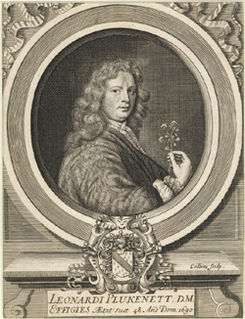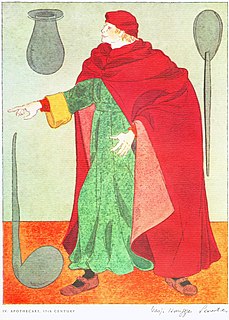Historia Plantarum has been used as all or part of the name of several books, which include:
The year 1686 in science and technology involved some significant events.

Sir William Jardine, 7th Baronet of Applegarth FRS FRSE FLS FSA was a Scottish naturalist. He is known for his editing of a long series of natural history books, The Naturalist's Library.
John Baptist Banister was an English clergyman and one of the first university-trained naturalists in North America. His primary focus was botany but he also studied insects and molluscs. He was sent out as a missionary chaplain by the garden-loving Bishop Henry Compton, with whom he soon established a correspondence. Banister was first in Barbados in the West Indies and then by April 1679 in Virginia, where, while serving a rector of the parish of Charles City he became one of Bishop Compton's most energetic plant collectors, "the first Virginia botanist of any note".

Robert Morison was a Scottish botanist and taxonomist. A forerunner of John Ray, he elucidated and developed the first systematic classification of plants.

Nikolaus Joseph Freiherr von Jacquin or Baron Nikolaus von Jacquin was a scientist who studied medicine, chemistry and botany.

Species Plantarum is a book by Carl Linnaeus, originally published in 1753, which lists every species of plant known at the time, classified into genera. It is the first work to consistently apply binomial names and was the starting point for the naming of plants.

The history of plant systematics—the biological classification of plants—stretches from the work of ancient Greek to modern evolutionary biologists. As a field of science, plant systematics came into being only slowly, early plant lore usually being treated as part of the study of medicine. Later, classification and description was driven by natural history and natural theology. Until the advent of the theory of evolution, nearly all classification was based on the scala naturae. The professionalization of botany in the 18th and 19th century marked a shift toward more holistic classification methods, eventually based on evolutionary relationships.

Georg Joseph Kamel was a Jesuit missionary, pharmacist and naturalist known for producing the first comprehensive accounts of Philippine flora and fauna and for introducing Philippine nature to the European learned world. A number of Kamel's treatises were published in the Philosophical Transactions, while his descriptions of Philippine flora appeared as an appendix to the third volume of John Ray's Historia Plantarum.

John Stackhouse was an English botanist, primarily interested in Spermatophytes, algae and mycology. He was born in Probus, Cornwall and built Acton Castle, above Stackhouse Cove, Cornwall in order to further his studies in the propagation of algae from their spores. He was the author of Nereis Britannica; or a Botanical Description of British Marine Plants, in Latin and English, accompanied with Drawings from Nature (1797).

George Johnston was a Scottish physician and naturalist.
The Ray Society is a scientific text publication society that publishes works devoted principally to British flora and fauna. As of 2017, it had published 179 volumes. These are predominantly academic works of interest to naturalists, zoologists, botanists and collectors.

Leonard Plukenet (1641–1706) was an English botanist, Royal Professor of Botany and gardener to Queen Mary. Plukenet published Phytographia in four parts in which he described and illustrated rare exotic plants. It is a copiously illustrated work of more than 2 700 figures and is frequently cited in books and papers from the 17th century to the present. He collaborated with John Ray in the second volume of Historia Plantarum.

Francesco Cupani was an Italian naturalist mainly interested in botany.
Samuel Doody (1656–1706) was an early English botanist.
Sir Tancred Robinson was an English physician, known also as a naturalist.
Samuel Browne or Brown was an English surgeon and botanist. He worked in the English East India Company factory at Fort St. George, Madras. Aside from his work he collected specimens of the local plants, especially grasses, along with vernacular names and made notes on their applications in medicine and other traditional use. He corresponded with several other contemporary naturalists including John Ray, Georg Joseph Kamel and James Petiver.

Edward Bulkley was an East India Company surgeon (1602-1709) posted in Madras and a pioneer naturalist. He corresponded with James Petiver and was the first to document the bird species of which a list of birds was published by John Ray. Ray incorrectly notes him as "Buckley". Bulkley also studied the local plants and corresponded with the Jesuit botanist Georg Joseph Kamel and acted as an intermediary between Kamel and Petiver. Bulkley corresponded with Charles du Bois on plants and collected Tamil and Telugu names for many medicinal and economically useful plants.


















